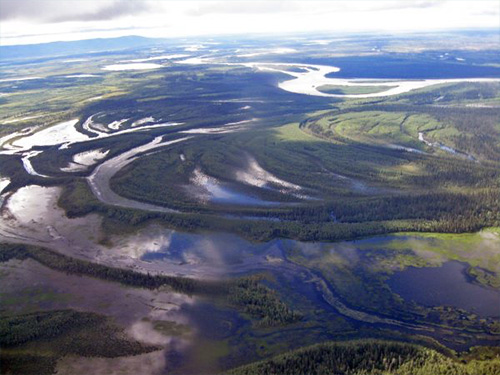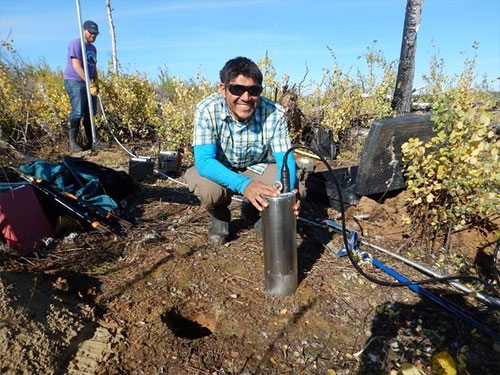
Scientists find pre-earthquake activity in central AlaskaBy FRITZ FREUDENBERGER
June 05, 2018
“Our observations have recorded an unequivocally interesting sequence of events,” Tape said. Tape and his colleagues found evidence for accelerating activity before a 2016 earthquake in a laterally moving fault zone in central Alaska. The activity included a phenomenon known as very low-frequency earthquakes, referring to the type of energy waves associated with it.
Typical earthquakes have two associated energy waves, called the P and S waves. Very low-frequency earthquakes do not have such signals. Instead, their waves occur on much lower frequencies. “Most earthquakes start abruptly, but not always,” said Luciana Astiz, a program director in the National Science Foundation’s Division of Earth Sciences, which supported the research. “A fault zone in central Alaska monitored by new scientific instruments offers a look at a more complex process. This study reports the first observations of a slow process that transitions into an earthquake — something previously observed only in laboratory experiments. These new observations contribute toward understanding the physics of earthquakes.” In 2015, Tape installed 13 seismic stations in the Minto Flats of central Alaska to capture the area’s fault activity. Nine days later, the instruments recorded a long-duration, very low-frequency process, normally only seen in deep subduction zones. This event showed a small amount of activity gathering, or nucleating, in a central area below the surface. It did not lead to an earthquake. A second, similar event in 2016 led to a key observation. At Minto Flats, a magnitude 3.7 quake occurred at a depth of about 10.5 miles, not an unusual event in itself. However, the event was preceded by a 12-hour accelerating sequence of earthquakes and 22 seconds of distinct high- and low-frequency waves in a concentrated area. Tape said that this kind of slow event transitioning into a rupture had previously only been seen in laboratory experiments. “The rupture process started, then it found a patch of the fault that was ready to go, and that’s what people have not seen. It’s really exciting,” Tape said. “The leap we make, and maybe the more controversial thing, is that this emergent long-period signal only seen on top of the fault is a low-frequency signal that can sometimes turn into an earthquake and sometimes not,” Tape said. Tape and his colleagues may have seen this kind of activity before. In 2012, there was a similar small event recorded in central Alaska. At that time, a magnitude 8.6 earthquake took place under the Indian Ocean and its energy was felt around the world. Because of the magnitude of this event, the smaller activity from central Alaska was overshadowed. Whatever signal the Minto Flats site gave off could not be confirmed. However, it was intriguing enough to help justify putting sensors in the area.
“Never in my wildest dreams did I expect we’d see something like that again,” Tape said. “I assumed that the conditions that happened in 2012 were somehow unique and that huge surface waves led to this nucleation. Even though I proposed putting instruments on the area in a proposal, it was the last item I put on. I thought, “Maybe we’ll see something crazy out there.'” By 2016, Tape had high-quality stations on top of the Minto Flat faults, around 18 miles from the main events, and no triggering earthquake to complicate the data. “We are staring right at this process, and what it showed was that exactly during the tremor-like signal there is this emergent long-duration signal that hints at what’s driving this nucleation phase,” he said. Geologists have been looking for something like this for a long time. So why hasn’t anyone seen it? “I’m left saying ‘I don’t know,’” Tape said. “I’m going to assume everyone has been looking for something before the P wave forever. It leads me to believe there is something special about this fault zone.” Minto Flats has a deep sedimentary basin, strike-slip faulting, active tectonics and deep earthquakes; it is an unusual site. “In some ways, I wish there wasn’t anything special. I wish it was a global phenomenon that we discovered, but it’s not,” Tape said. “It appears there is something special about the conditions in Minto Flats.” The results of the research will appear in the latest issue of the journal Nature Geoscience. The paper is titled “Earthquake Nucleation and Fault Slip Complexity in the Lower Crust of Central Alaska.” The project was primarily funded by a National Science Foundation CAREER project that supported Tape and his student co-authors, Vipul Silwal and Kyle Smith.
Representations of fact and opinions in comments posted are solely those of the individual posters and do not represent the opinions of Sitnews.
|
|||||

